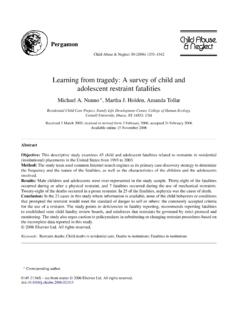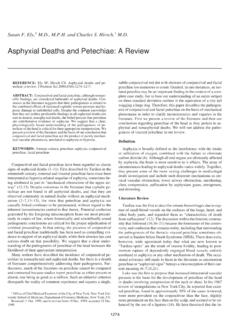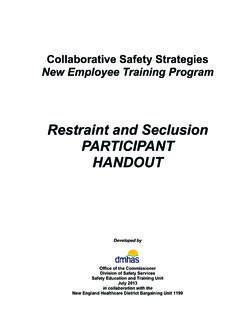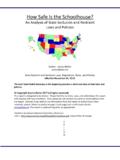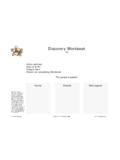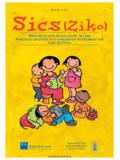Transcription of Excited Delirium, Restraint Asphyxia, Positional …
1 Excited delirium , Restraint asphyxia , Positional asphyxia and 'In-Custody Death" SyndromesExcited delirium , Restraint asphyxia , Positional asphyxia and "In-Custody Death" Syndromes: Controversial theories that may explain why some children in treatment programs die when restrained."..As a matter of law, any individual who chooses to restrain someone may be charged and found responsible for the intended or unintended impact."Revised: October 05, 2005 More information: year a small number of people die suddenly while restrained. Most of these deaths are associated with individuals who were restrained while being taken into custody during a violent police encounter. Other cases of sudden Restraint death involve individuals in detention or residential treatment programs who were restrained during violent encounters while also under the influence of psychiatric medications.
2 No one is certain how many Restraint related sudden deaths occur each year. Identifying the exact cause of death is the biggest problem. The number of estimated deaths are in question but may range between 50 and 125 per year. Some estimates are is a great deal of confusion about the cause and circumstances surrounding Restraint related sudden deaths. Most of this confusion seems to be the result of trying to understand a complicated interaction between the behavior of the people involved as well as the psychological and medical condition of the deceased. Sudden death after individuals were taken into police custody has been reported for several decades. The term "in-custody" death syndrome was first used to describe unexplained deaths when there was no apparent cause other than a police arrest.
3 It was then observed that these individuals were often injured and sometimes beaten severely as a result of violent conflicts with police. With further investigation and during litigation it was proposed that there appeared to be a risk of death during the Restraint of these same individuals who were also exhibiting an extreme form of behavioral disturbance that went far beyond the "distressed' state that police normally faced. The main features of this extreme state included agitation, excitability, paranoia, aggression, great strength and non-response to pain. Such behavior is now referred to as "acute behavioral disturbance". The term 'acute" refers to a rapid onset (hours) and not gradual onset (weeks) of this behavior. There are many potential causes of an acute behavioral disturbance.
4 These include brain tumors, infection, delirium from high temperature, heat exhaustion, thyroid disease as well as (1 of 5)1/19/2006 12:47:45 PMExcited delirium , Restraint asphyxia , Positional asphyxia and 'In-Custody Death" Syndromeshigh and low blood sugar. Illegal drugs as well as medications can also produce acute behavioral disturbances. In addition, psychiatric medications used to treat schizophrenia, bipolar disorder, depression, anxiety, attention deficit and hyperactivity can cause serious health problems as well as acute behavioral disturbances. Some of these drugs include resperdal, prozac, zoloft, adderral, concerta, ritalin, Without question, the side effects of therapeutic drugs as well as the interaction effects between drugs can cause serious behavioral problems - especially if the patient is taking too much or they are trying a new medication.
5 Illegal drugs such as PCP, cocaine, methamphetamines and other stimulants are known to cause acute behavioral disturbances - especially in high dosages or over extended periods of time. We do not know whether or not Restraint alone will increase the likelihood death. Exhaustion, exertion and Restraint combined are associated with a high rate of sudden death. In addition, the side effects of therapeutic and illicit drugs carry a risk of sudden death as well. Medical conditions such as high blood pressure, asthma, heart disease or an enlarged heart carry a high risk of sudden death. Controversial theories suggest that the use of stimulants such as cocaine and methamphetamines may create a lasting risk of heart attack. Some professionals are concerned that the use of drugs such as adderral, ritalin, concerta, [stimulants used to treat ADHD] may carry a risk of heart attack in the same way that other stimulants such as crack cocaine and methamphetamines can.
6 What we do know is that there is a higher rate of sudden death during Restraint encounters. We also know that there are additional factors that may occur at the same time that increase the risk of sudden death. Some of these include include fear, panic, paranoia, aggression, exhaustion, exertion, medical problems, medication effects, illicit drug use, restricted breathing, Restraint or Positional asphyxia , and adrenaline. Combinations of these factors may multiply the effect. We are not entirely sure what is the cause because we cannot study these factors in a controlled manner. Positional and Restraint AsphyxiaThe term asphyxia , roughly speaking, means a restriction of breathing and other process that interferes with the natural transport of oxygen and carbon dioxide in and out of the body.
7 Positional asphyxia is a term used to describe the placement of a body in a position that interferes with the ability to breath. Breathing can be restricted by compression of the chest or abdomen as well as restricting or blocking the airway. In addition, restraining, lifting or moving someone can also cause an individual to tighten their muscles and thereby restrict breathing. Most people will tense their muscles when restrained or moved forcefully against their will. In a case of Restraint asphyxia , the cause of death is usually a combination of exhaustion, exertion, fear and restricted breathing due to Restraint or the use of force. The cause of death in Positional asphyxia may involve Restraint but is more likely associated with leaving an exhausted, drug affected and unconscious person in a position that results in asphyxia .
8 The phrase " Restraint asphyxia " will raise concerns about the reasonableness of the use of force and Restraint . Restricted breathing as the cause of death may lead to charges of manslaughter and even murder. Death by asphyxia is believed to be a horrific experience for which the (2 of 5)1/19/2006 12:47:45 PMExcited delirium , Restraint asphyxia , Positional asphyxia and 'In-Custody Death" Syndromesindividual will exert tremendous physical effort in order to breath. Excited delirium SyndromeA delirium is characterized by a severe disturbance in the level of consciousness and a change in mental status over a relatively short period of time. There is a reduced clarity of awareness of their environment. The ability to focus, sustain or shift attention is impaired.
9 The individual's attention wanders and is easily distracted by other stimuli. The individual is almost certainly disoriented and may not know what year it is, where they are, what they are doing and the impact of their behavior. Perceptual disturbances are common and the person may hallucinate. A delirium is the result of a serious and potentially life threatening medical condition. Potential causes include infection, head trauma, fever, adverse reactions to medications or overdose of illegal drugs such as cocaine and methamphetamines. Any person who is delirious requires prompt medical evaluation and delirious person is likely to manifest an acute behavioral disturbance. These individuals can appear normal until they are questioned, challenged or confronted.
10 When confronted or frightened these individuals can become oppositional, defiant, angry, paranoid and aggressive. Further confrontation, threats and use of force will almost certainly result in further aggression and even violence. Attempting to restrain and control these individuals can be difficult because they frequently possess unusual strength, pain insensitivity and instinctive resistance to any use of force. As many as 5 to 8 people may be required to restrain one delirious adult. The Controversy of Positional asphyxia , Restraint asphyxia and Excited delirium SyndromesProponents of " Excited delirium " death syndrome as the cause of death argue that most people who die during Restraint are not the victims of incompetence or brutality, but rather victims of their own cocaine and amphetamine abuse, which can trigger this fatal condition.
